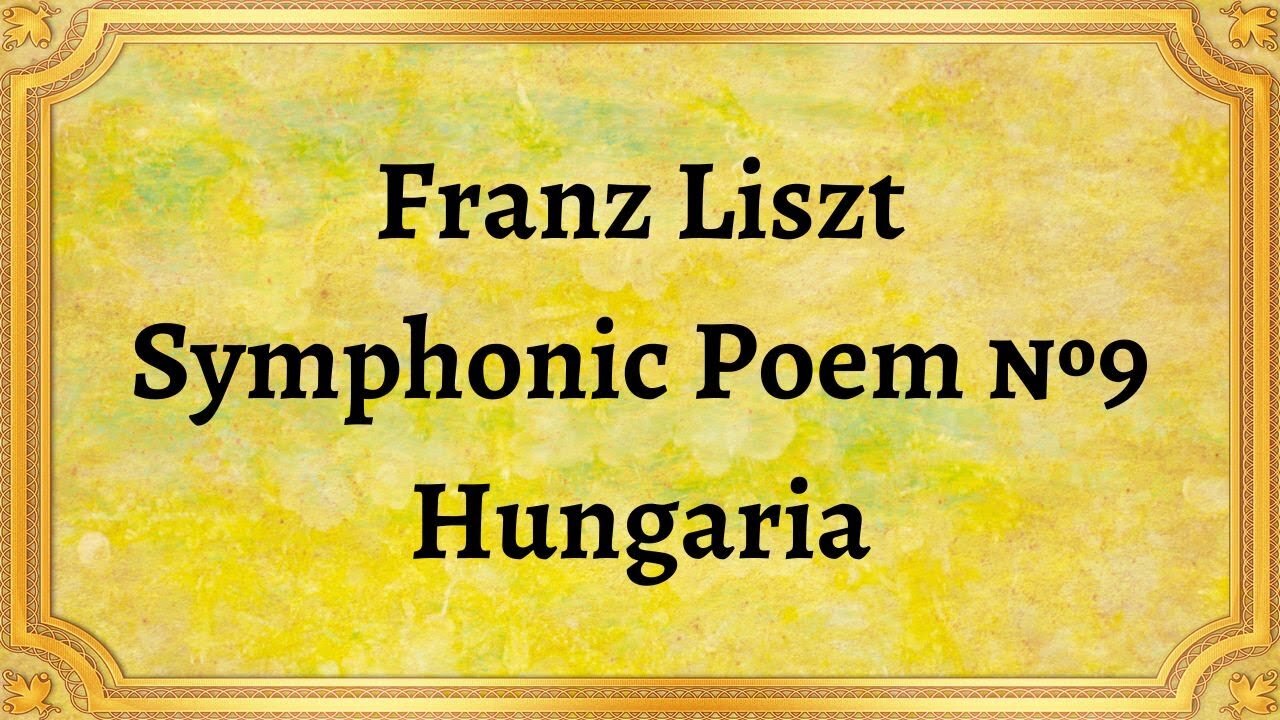Premium Only Content

Franz Liszt Symphonic Poem №9 Hungaria
#classicalmusic #FranzLiszt #SymphonicPoemNo9 #Hungaria #orchestralmusic #Hungariancomposer #musicalcomposition #symphonicpoem #Romanticera #nationalisticmusic #virtuosicpianowriting #culturalheritage #Hungarianfolklore #symphonicstorytelling #powerfulmelodies #expressiveharmonies #audienceengagement #onlinevisibility #audiencereach
Publication date 1951
MUNICH PHILHARMONIC ORCHESTRA under Adam Dolzycki
Franz Liszt, a renowned Hungarian composer of the Romantic era, left an indelible mark on the world of classical music. Among his many remarkable compositions, the Symphonic Poem No. 9, popularly known as "Hungaria," stands as a testament to his musical genius and his deep connection to his Hungarian roots.
Liszt's "Hungaria" emerges from the rich tapestry of Hungarian history and folklore. It was composed in 1856, during a time when Hungary was struggling for independence and national identity. The symphonic poem embodies Liszt's deep love for his homeland and his desire to celebrate its cultural heritage through music. By incorporating elements of Hungarian folk melodies and rhythms, Liszt created a musical work that resonated with the Hungarian people, serving as a source of nationalistic pride and unity during a politically tumultuous era.
The Symphonic Poem No. 9 "Hungaria" showcases Liszt's mastery of orchestration and his innovative approach to musical storytelling. The piece begins with a bold and majestic introduction, immediately capturing the listener's attention. Liszt then weaves together various thematic materials, evoking a sense of drama, passion, and patriotism. The composition unfolds through contrasting sections, alternating between lyrical melodies, energetic dance-like passages, and powerful climaxes. Liszt's virtuosic piano writing, a trademark of his style, is also evident in the piece, adding an additional layer of brilliance and technical prowess.
One of the defining characteristics of "Hungaria" is Liszt's ability to evoke a wide range of emotions through his use of harmonies and melodies. The piece showcases a fascinating blend of Hungarian and Western musical influences, combining dramatic and expressive harmonies with folk-inspired melodies. Liszt's skillful orchestration adds depth and color to the composition, with moments of lush string passages, vibrant brass fanfares, and delicate woodwind solos. The symphonic poem's emotional intensity and evocative melodies create a powerful and immersive listening experience.
Liszt's Symphonic Poem No. 9 "Hungaria" has left an enduring impact on the world of classical music. Beyond its artistic brilliance, the composition holds significant cultural value for the Hungarian people. It has become a symbol of national pride and identity, representing the rich heritage and resilience of Hungary. The piece has been performed by orchestras worldwide, captivating audiences with its grandeur, emotional depth, and vibrant musicality.
Franz Liszt's Symphonic Poem No. 9 "Hungaria" stands as a testament to the composer's profound musical talent and his deep connection to his Hungarian roots. Through this composition, Liszt weaves together elements of Hungarian folklore and Western musical traditions, creating a captivating and evocative musical journey. "Hungaria" not only showcases Liszt's mastery of orchestration and composition but also serves as a powerful symbol of nationalistic pride and cultural heritage. Its enduring legacy continues to captivate audiences, allowing them to experience the rich tapestry of Hungarian history and the brilliance of Liszt's musical genius.
You have the opportunity to support the channel https://destream.net/live/RadSiarAl/donate
-
 22:54
22:54
Classical music_Music Inspiration
15 days agoLudwig van Beethoven Quartet No. 6 in B-flat major, Op. 18 No. 6
302 -
 1:06:19
1:06:19
BonginoReport
5 hours agoManhunt Underway for Charlie Kirk’s Assassin - Nightly Scroll w/ Hayley Caronia (Ep.132)
214K122 -
 LIVE
LIVE
Flyover Conservatives
13 hours agoStructural Architect Destroys 9.11 Narrative... What Really Happened? - Richard Gage AIA | FOC Show
227 watching -
 LIVE
LIVE
Precision Rifle Network
8 hours agoS5E1 Guns & Grub - Charlie Kirk's "sniper"
128 watching -
 LIVE
LIVE
LFA TV
16 hours agoLFA TV ALL DAY STREAM - THURSDAY 9/11/25
1,012 watching -
 1:01:56
1:01:56
The Nick DiPaolo Show Channel
5 hours agoDems + Media Killed Kirk | The Nick Di Paolo Show #1792
82.3K75 -
 1:35:10
1:35:10
LIVE WITH CHRIS'WORLD
7 hours agoLIVE WITH CHRIS’WORLD - WE ARE CHARLIE KIRK! Remembering a Legend
16.1K3 -
 50:24
50:24
Donald Trump Jr.
7 hours agoFor Charlie
354K397 -

Quite Frankly
8 hours agoTipping Point USA? & Open Lines | 9/11/25
57.4K4 -
 1:04:09
1:04:09
TheCrucible
4 hours agoThe Extravaganza! EP: 35 (9/11/25)
81.9K22